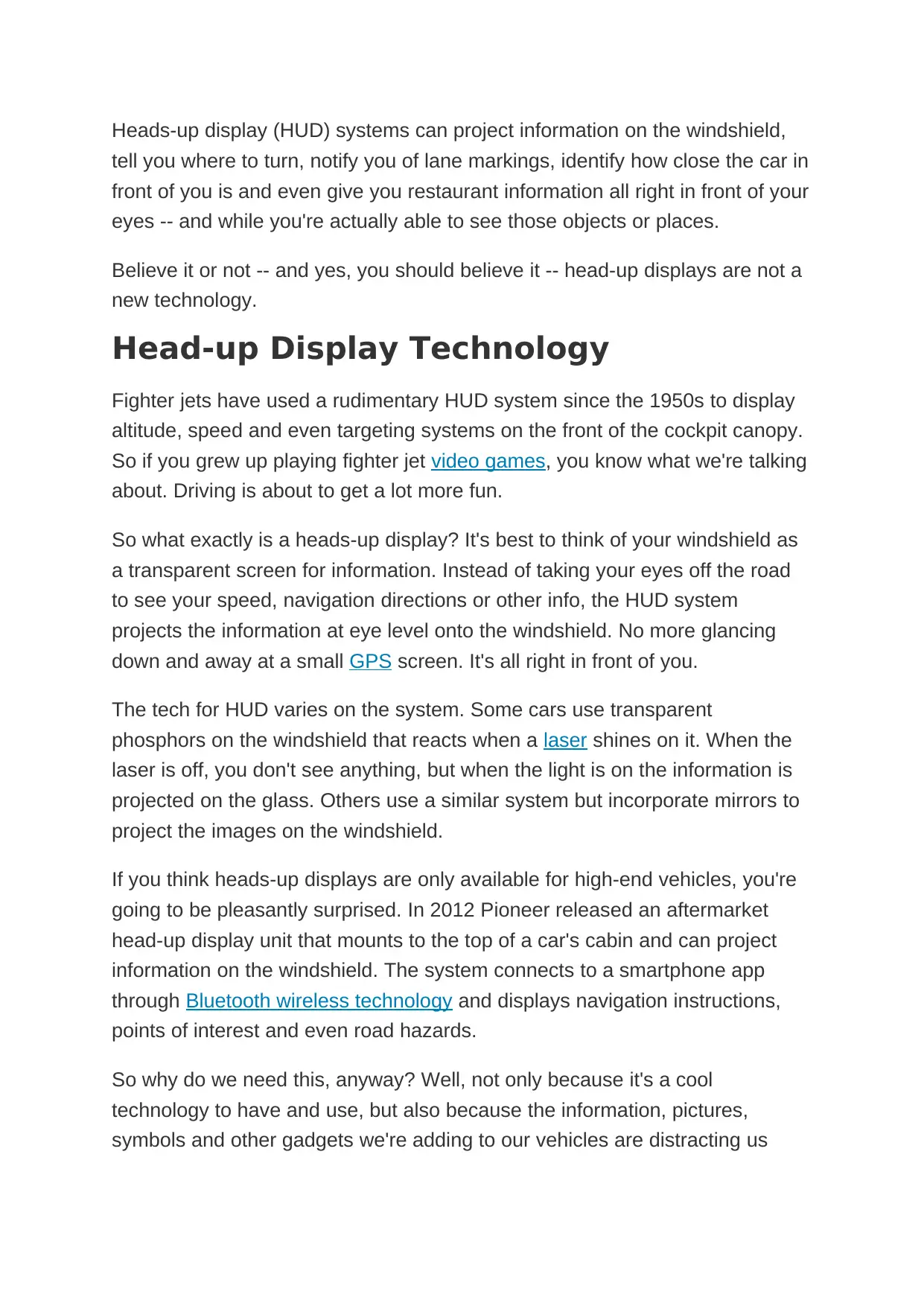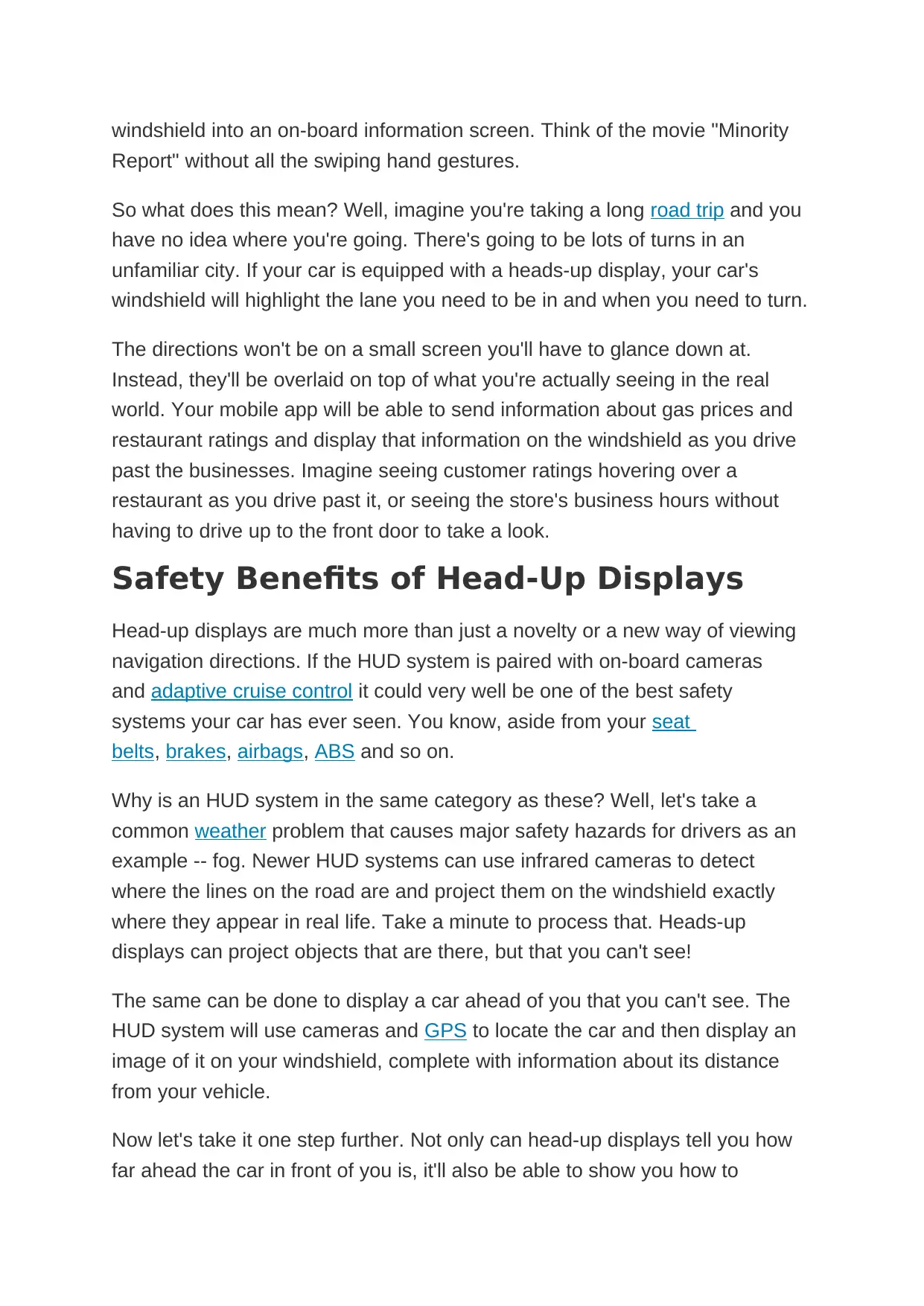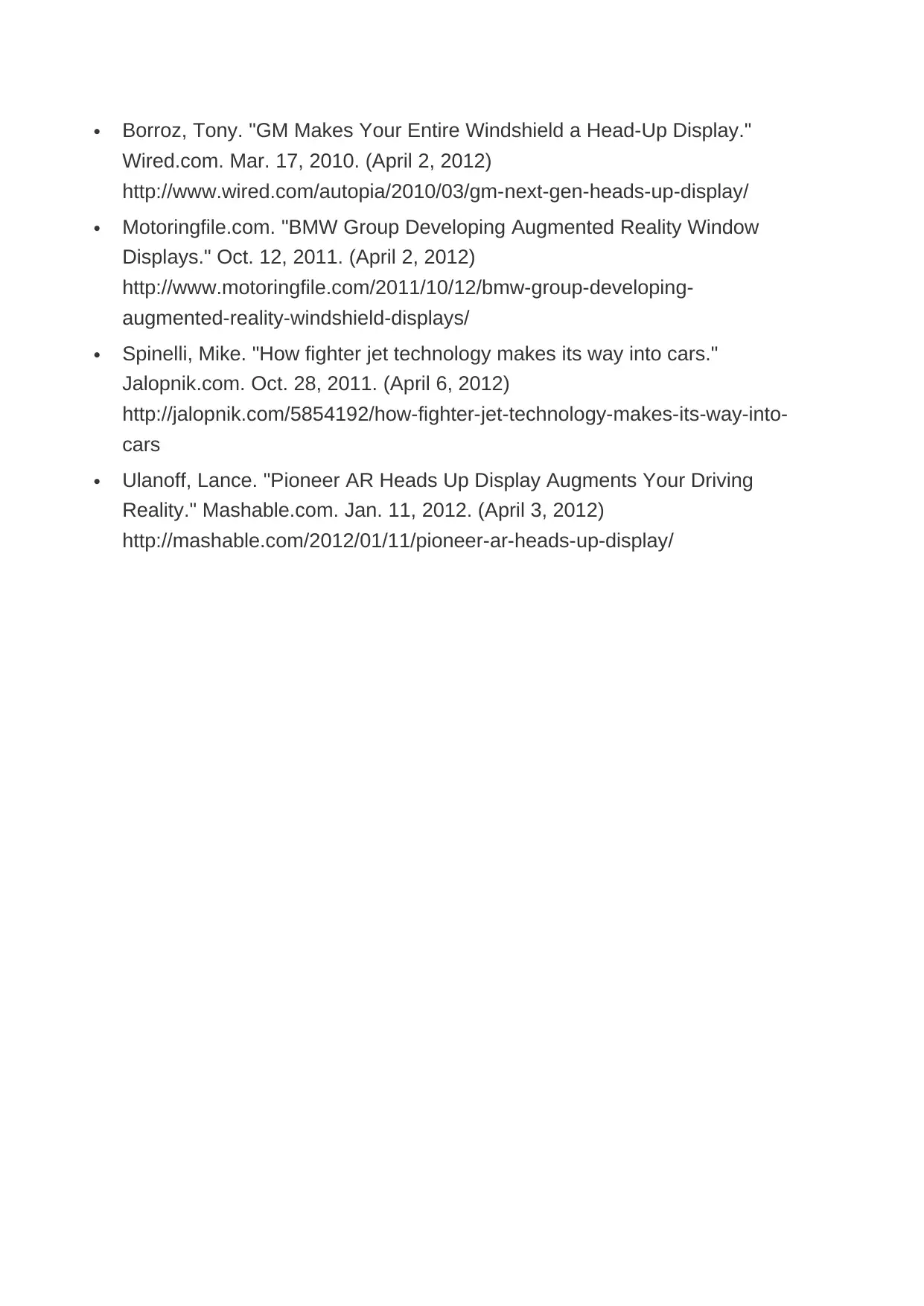Head-Up Display Technology: Evolution, Benefits, and Future Trends
VerifiedAdded on 2023/04/21
|6
|1577
|230
Report
AI Summary
This report provides a comprehensive overview of head-up display (HUD) technology. It begins by explaining the basic concept of HUDs, which project information onto the windshield, allowing drivers to keep their eyes on the road. The report traces the evolution of HUDs from rudimentary systems in fighter jets to the advanced augmented reality (AR) systems found in modern cars. It details how HUDs work, using technologies like transparent phosphors and mirrors to project images. The report highlights the safety benefits of HUDs, such as displaying lane markings, highlighting potential hazards, and providing navigation directions. It also discusses the integration of HUDs with other technologies, like infrared cameras and adaptive cruise control, to enhance driver safety. Furthermore, the report explores the future of HUD technology, including the potential for AR to revolutionize driving by integrating with GPS, the internet, and mobile apps to provide real-time information and assistance. The report concludes by emphasizing the potential of HUDs to reduce accidents, assist drivers with visual impairments, and improve overall driving safety.

How Head-up Displays Work
BY CHRISTOPHER NEIGER
Browse the article How Head-up Displays Work
The 2012 GMC Acadia's heads-up display allows drivers to safety merge onto the highway
using technology similar to what fighter pilots use to guide precise movements at
supersonic speeds. See more car safety pictures.
© GENERAL MOTORS
Two of the most important parts of driving are being able to see well and
knowing where you're going. Head-up display technology works with both of
those ideas in mind -- and it's going to change the way we see the road
forever.
The days of looking away from the road, missing a turn because you didn't
understand the GPS or driving blind in the fog may soon be a thing of the
past.
BY CHRISTOPHER NEIGER
Browse the article How Head-up Displays Work
The 2012 GMC Acadia's heads-up display allows drivers to safety merge onto the highway
using technology similar to what fighter pilots use to guide precise movements at
supersonic speeds. See more car safety pictures.
© GENERAL MOTORS
Two of the most important parts of driving are being able to see well and
knowing where you're going. Head-up display technology works with both of
those ideas in mind -- and it's going to change the way we see the road
forever.
The days of looking away from the road, missing a turn because you didn't
understand the GPS or driving blind in the fog may soon be a thing of the
past.
Paraphrase This Document
Need a fresh take? Get an instant paraphrase of this document with our AI Paraphraser

Heads-up display (HUD) systems can project information on the windshield,
tell you where to turn, notify you of lane markings, identify how close the car in
front of you is and even give you restaurant information all right in front of your
eyes -- and while you're actually able to see those objects or places.
Believe it or not -- and yes, you should believe it -- head-up displays are not a
new technology.
Head-up Display Technology
Fighter jets have used a rudimentary HUD system since the 1950s to display
altitude, speed and even targeting systems on the front of the cockpit canopy.
So if you grew up playing fighter jet video games, you know what we're talking
about. Driving is about to get a lot more fun.
So what exactly is a heads-up display? It's best to think of your windshield as
a transparent screen for information. Instead of taking your eyes off the road
to see your speed, navigation directions or other info, the HUD system
projects the information at eye level onto the windshield. No more glancing
down and away at a small GPS screen. It's all right in front of you.
The tech for HUD varies on the system. Some cars use transparent
phosphors on the windshield that reacts when a laser shines on it. When the
laser is off, you don't see anything, but when the light is on the information is
projected on the glass. Others use a similar system but incorporate mirrors to
project the images on the windshield.
If you think heads-up displays are only available for high-end vehicles, you're
going to be pleasantly surprised. In 2012 Pioneer released an aftermarket
head-up display unit that mounts to the top of a car's cabin and can project
information on the windshield. The system connects to a smartphone app
through Bluetooth wireless technology and displays navigation instructions,
points of interest and even road hazards.
So why do we need this, anyway? Well, not only because it's a cool
technology to have and use, but also because the information, pictures,
symbols and other gadgets we're adding to our vehicles are distracting us
tell you where to turn, notify you of lane markings, identify how close the car in
front of you is and even give you restaurant information all right in front of your
eyes -- and while you're actually able to see those objects or places.
Believe it or not -- and yes, you should believe it -- head-up displays are not a
new technology.
Head-up Display Technology
Fighter jets have used a rudimentary HUD system since the 1950s to display
altitude, speed and even targeting systems on the front of the cockpit canopy.
So if you grew up playing fighter jet video games, you know what we're talking
about. Driving is about to get a lot more fun.
So what exactly is a heads-up display? It's best to think of your windshield as
a transparent screen for information. Instead of taking your eyes off the road
to see your speed, navigation directions or other info, the HUD system
projects the information at eye level onto the windshield. No more glancing
down and away at a small GPS screen. It's all right in front of you.
The tech for HUD varies on the system. Some cars use transparent
phosphors on the windshield that reacts when a laser shines on it. When the
laser is off, you don't see anything, but when the light is on the information is
projected on the glass. Others use a similar system but incorporate mirrors to
project the images on the windshield.
If you think heads-up displays are only available for high-end vehicles, you're
going to be pleasantly surprised. In 2012 Pioneer released an aftermarket
head-up display unit that mounts to the top of a car's cabin and can project
information on the windshield. The system connects to a smartphone app
through Bluetooth wireless technology and displays navigation instructions,
points of interest and even road hazards.
So why do we need this, anyway? Well, not only because it's a cool
technology to have and use, but also because the information, pictures,
symbols and other gadgets we're adding to our vehicles are distracting us

from the road. We need a new way to display this information that keeps our
eyes up and on the road -- hence, the heads-up display.
The Evolution of Head-Up Displays
GM's full windshield head-up display technology, combined with night vision technology,
allows for objects, such as deer, to be highlighted for the driver, preventing potential
accidents.
© GENERAL MOTORS
General Motors introduced the first heads-up display in a car in 1988 and the
systems were originally used for showing speed, tachometer and other basic
readings from the dashboard. But as the technology advanced, much more
sophisticated and critical information is being displayed.
The original head-up displays are being replaced with newer technology
called augmented reality (AR). These AR systems are the new version of
head-up displays, but are far more advanced. ARs can integrate with GPS
systems, infrared cameras, the Internet and mobile apps to turn your car's
eyes up and on the road -- hence, the heads-up display.
The Evolution of Head-Up Displays
GM's full windshield head-up display technology, combined with night vision technology,
allows for objects, such as deer, to be highlighted for the driver, preventing potential
accidents.
© GENERAL MOTORS
General Motors introduced the first heads-up display in a car in 1988 and the
systems were originally used for showing speed, tachometer and other basic
readings from the dashboard. But as the technology advanced, much more
sophisticated and critical information is being displayed.
The original head-up displays are being replaced with newer technology
called augmented reality (AR). These AR systems are the new version of
head-up displays, but are far more advanced. ARs can integrate with GPS
systems, infrared cameras, the Internet and mobile apps to turn your car's
⊘ This is a preview!⊘
Do you want full access?
Subscribe today to unlock all pages.

Trusted by 1+ million students worldwide

windshield into an on-board information screen. Think of the movie "Minority
Report" without all the swiping hand gestures.
So what does this mean? Well, imagine you're taking a long road trip and you
have no idea where you're going. There's going to be lots of turns in an
unfamiliar city. If your car is equipped with a heads-up display, your car's
windshield will highlight the lane you need to be in and when you need to turn.
The directions won't be on a small screen you'll have to glance down at.
Instead, they'll be overlaid on top of what you're actually seeing in the real
world. Your mobile app will be able to send information about gas prices and
restaurant ratings and display that information on the windshield as you drive
past the businesses. Imagine seeing customer ratings hovering over a
restaurant as you drive past it, or seeing the store's business hours without
having to drive up to the front door to take a look.
Safety Benefits of Head-Up Displays
Head-up displays are much more than just a novelty or a new way of viewing
navigation directions. If the HUD system is paired with on-board cameras
and adaptive cruise control it could very well be one of the best safety
systems your car has ever seen. You know, aside from your seat
belts, brakes, airbags, ABS and so on.
Why is an HUD system in the same category as these? Well, let's take a
common weather problem that causes major safety hazards for drivers as an
example -- fog. Newer HUD systems can use infrared cameras to detect
where the lines on the road are and project them on the windshield exactly
where they appear in real life. Take a minute to process that. Heads-up
displays can project objects that are there, but that you can't see!
The same can be done to display a car ahead of you that you can't see. The
HUD system will use cameras and GPS to locate the car and then display an
image of it on your windshield, complete with information about its distance
from your vehicle.
Now let's take it one step further. Not only can head-up displays tell you how
far ahead the car in front of you is, it'll also be able to show you how to
Report" without all the swiping hand gestures.
So what does this mean? Well, imagine you're taking a long road trip and you
have no idea where you're going. There's going to be lots of turns in an
unfamiliar city. If your car is equipped with a heads-up display, your car's
windshield will highlight the lane you need to be in and when you need to turn.
The directions won't be on a small screen you'll have to glance down at.
Instead, they'll be overlaid on top of what you're actually seeing in the real
world. Your mobile app will be able to send information about gas prices and
restaurant ratings and display that information on the windshield as you drive
past the businesses. Imagine seeing customer ratings hovering over a
restaurant as you drive past it, or seeing the store's business hours without
having to drive up to the front door to take a look.
Safety Benefits of Head-Up Displays
Head-up displays are much more than just a novelty or a new way of viewing
navigation directions. If the HUD system is paired with on-board cameras
and adaptive cruise control it could very well be one of the best safety
systems your car has ever seen. You know, aside from your seat
belts, brakes, airbags, ABS and so on.
Why is an HUD system in the same category as these? Well, let's take a
common weather problem that causes major safety hazards for drivers as an
example -- fog. Newer HUD systems can use infrared cameras to detect
where the lines on the road are and project them on the windshield exactly
where they appear in real life. Take a minute to process that. Heads-up
displays can project objects that are there, but that you can't see!
The same can be done to display a car ahead of you that you can't see. The
HUD system will use cameras and GPS to locate the car and then display an
image of it on your windshield, complete with information about its distance
from your vehicle.
Now let's take it one step further. Not only can head-up displays tell you how
far ahead the car in front of you is, it'll also be able to show you how to
Paraphrase This Document
Need a fresh take? Get an instant paraphrase of this document with our AI Paraphraser

maneuver around another car to avoid an accident or other road hazards.
Some adaptive cruise control systems already make safety calculations to
determine the best route for a car around a certain situation, but the next step
is to actually project that information, in real-time, on the car's windshield.
We won't be driving blind in the fog, rain or snowstorms anymore. Our cars will
see what we simply can't, and then show us as if we're seeing it ourselves.
HUD is here, and we may never see driving the same way again.
Author's Note
As I researched head-up displays I wondered if having all this information on
our windshields is too much for us to handle. But as I saw the systems that
are in development, I began to understand how HUDs will someday allow all
of us to become better drivers. It can be available when we need it and we
can turn it off when we don't want it.
Most of us are accustomed to having information at our fingertips all day long,
so it makes sense to bring that same idea into our cars in more ways than just
for music or entertainment. If HUD systems continue to develop at the rate
they are right now, it won't be long before we're able to reduce accidents,
assist drivers with vision impairments and see our surroundings a little clearer.
Related Articles
Top 5 Most Important Upcoming Car Technologies
5 Future Car Technologies That Truly Have a Chance
How Augmented Reality Works
How Dashboard Displays Work
How Seatbelts Work
How Pre-Collision Systems Work
What is the purpose of a seatbelt pretensioner?
Sources
Some adaptive cruise control systems already make safety calculations to
determine the best route for a car around a certain situation, but the next step
is to actually project that information, in real-time, on the car's windshield.
We won't be driving blind in the fog, rain or snowstorms anymore. Our cars will
see what we simply can't, and then show us as if we're seeing it ourselves.
HUD is here, and we may never see driving the same way again.
Author's Note
As I researched head-up displays I wondered if having all this information on
our windshields is too much for us to handle. But as I saw the systems that
are in development, I began to understand how HUDs will someday allow all
of us to become better drivers. It can be available when we need it and we
can turn it off when we don't want it.
Most of us are accustomed to having information at our fingertips all day long,
so it makes sense to bring that same idea into our cars in more ways than just
for music or entertainment. If HUD systems continue to develop at the rate
they are right now, it won't be long before we're able to reduce accidents,
assist drivers with vision impairments and see our surroundings a little clearer.
Related Articles
Top 5 Most Important Upcoming Car Technologies
5 Future Car Technologies That Truly Have a Chance
How Augmented Reality Works
How Dashboard Displays Work
How Seatbelts Work
How Pre-Collision Systems Work
What is the purpose of a seatbelt pretensioner?
Sources

Borroz, Tony. "GM Makes Your Entire Windshield a Head-Up Display."
Wired.com. Mar. 17, 2010. (April 2, 2012)
http://www.wired.com/autopia/2010/03/gm-next-gen-heads-up-display/
Motoringfile.com. "BMW Group Developing Augmented Reality Window
Displays." Oct. 12, 2011. (April 2, 2012)
http://www.motoringfile.com/2011/10/12/bmw-group-developing-
augmented-reality-windshield-displays/
Spinelli, Mike. "How fighter jet technology makes its way into cars."
Jalopnik.com. Oct. 28, 2011. (April 6, 2012)
http://jalopnik.com/5854192/how-fighter-jet-technology-makes-its-way-into-
cars
Ulanoff, Lance. "Pioneer AR Heads Up Display Augments Your Driving
Reality." Mashable.com. Jan. 11, 2012. (April 3, 2012)
http://mashable.com/2012/01/11/pioneer-ar-heads-up-display/
Wired.com. Mar. 17, 2010. (April 2, 2012)
http://www.wired.com/autopia/2010/03/gm-next-gen-heads-up-display/
Motoringfile.com. "BMW Group Developing Augmented Reality Window
Displays." Oct. 12, 2011. (April 2, 2012)
http://www.motoringfile.com/2011/10/12/bmw-group-developing-
augmented-reality-windshield-displays/
Spinelli, Mike. "How fighter jet technology makes its way into cars."
Jalopnik.com. Oct. 28, 2011. (April 6, 2012)
http://jalopnik.com/5854192/how-fighter-jet-technology-makes-its-way-into-
cars
Ulanoff, Lance. "Pioneer AR Heads Up Display Augments Your Driving
Reality." Mashable.com. Jan. 11, 2012. (April 3, 2012)
http://mashable.com/2012/01/11/pioneer-ar-heads-up-display/
⊘ This is a preview!⊘
Do you want full access?
Subscribe today to unlock all pages.

Trusted by 1+ million students worldwide
1 out of 6
Your All-in-One AI-Powered Toolkit for Academic Success.
+13062052269
info@desklib.com
Available 24*7 on WhatsApp / Email
![[object Object]](/_next/static/media/star-bottom.7253800d.svg)
Unlock your academic potential
Copyright © 2020–2025 A2Z Services. All Rights Reserved. Developed and managed by ZUCOL.